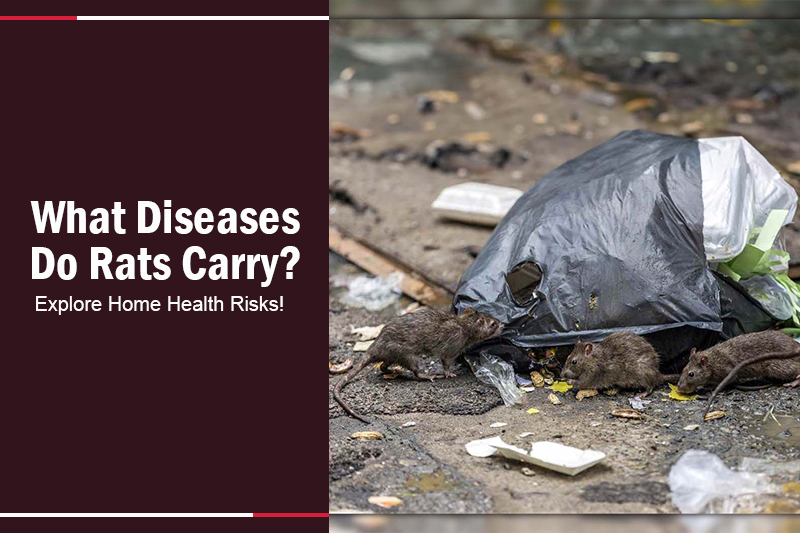If you’re dealing with unwanted rats in your home, it’s important to understand the health risks they pose. This includes learning about “What Diseases Do Rats Carry?”
Our blog post will guide you through the different diseases caused by rats to humans, helping you understand the potential health threats. We aim to provide the essential information needed to protect your home and family from these common invaders.

How Do Rats Transmit Diseases?
Rats, unfortunately, are carriers of numerous harmful pathogens that can infect humans through various means.
- Bites: When a rat bites a person, the microorganisms present in its saliva can enter the bloodstream directly, transmitting any diseases the rat may be carrying.
- Scratches: Similarly, if a rat scratches you, any pathogens it carries can enter your bloodstream through the wound.
- Excrement: Coming into direct contact with rat urine, feces, or saliva is a surefire way to catch a disease carried by rodents.
- Inhalation: Breathing in particles contaminated by rat urine or feces, such as dust particles in areas where rats have been present, can lead to infection.
- Direct Handling: Touching or handling rats that are disease carriers can also result in transmission.
- Consumption: Eating food or drinking water that has been contaminated by rat urine or has come into contact with rats can cause illness.
- Indirect Contact: Sometimes, pets can become intermediaries for diseases, catching them from rats and then passing them on to humans.
Besides these transmission methods, rats and similar rodents often host external parasites like fleas, ticks, and mites. These parasites can carry their own diseases, which can be transmitted to rats or directly to humans through any of the mentioned routes.

What Diseases Can You Get from Rats?
Rats and other rodents can be carriers of various diseases that pose serious health risks to humans. Among these, the Hantavirus is particularly concerning. This virus is often found in the white-footed mouse, cotton rat, and rice rat. It’s a severe disease without a specific treatment, cure, or vaccine available.

Hantarivus
Symptoms of Hantavirus include fever, fatigue, and muscle aches, particularly in the hips, backs, and thighs, and may also involve diarrhea, abdominal pain, nausea, and vomiting.
Lymphocytic Choriomeningtis Virus
Another disease, Lymphocytic Choriomeningitis Virus (LCMV), primarily spreads through the common house mouse. LCMV can manifest in two stages, where the initial phase includes symptoms like nausea, vomiting, headache, muscle aches, and loss of appetite. The second, more severe phase, can lead to neurological issues such as meningitis, encephalitis, or meningoencephalitis.
Plague
The Plague, a disease that caused devastating epidemics in the past, is also transmitted by rodents, specifically through flea bites. Caused by the bacterium Yersinia pestis, plague types—Bubonic, Septicemic, Pneumonic—vary based on how the infection affects the body (immune system, bloodstream, or lungs). Symptoms vary accordingly, and immediate antibiotic treatment is critical.
Salmonella
Rodents can also carry Salmonella in their digestive tract, making any contact with their waste potentially dangerous, especially if it leads to consuming contaminated food. Symptoms of a Salmonella infection include chills, fever, abdominal cramps, nausea, vomiting, and diarrhea.
Rat Bite Fever
Rat Bite Fever, despite its name, can be contracted not just through rat bites but also by handling infected rodents or consuming the bacteria. Symptoms include fever, skin rash, headaches, vomiting, rash, and muscle pain.
Tularemia
Tularemia, caused by the bacterium Francisella tularensis, is common in rodents, rabbits, and hares. It can be transmitted to humans through tick or deer fly bites or by handling infected animals. While potentially life-threatening, most Tularemia cases can be treated with antibiotics. The most common symptom is fever.
Note: To reduce the risk of contracting these diseases, avoid contact with rodents and their waste, properly store and dispose of food and trash, and report sightings of rodents in living or working spaces immediately. Implementing rodent exclusion measures, using snap traps for removal and monitoring, and taking precautions when cleaning up after infestations or in buildings that have been closed for some time are also recommended strategies.

How to Prevent Infection from Rats
Steering clear of rodents and their by-products like droppings, urine, saliva, and nesting materials is essential for your health and safety. It’s important to handle food and waste properly to avoid attracting these pests.
For those working or living in areas prone to rodent presence:
- Promptly report any signs of rodents to your maintenance team or supervisor.
- Work to keep rodents out by sealing off any openings larger than a quarter of an inch and maintaining a clear area of at least 18 inches from any vegetation to your building. You can find more detailed strategies in the NPS Rodent Exclusion Manual.
- Snap traps are an effective tool for both removing and keeping an eye on rodent populations.
- When dealing with the aftermath of a rodent infestation or tidying up spaces that have been closed for a while, follow specific guidelines for cleaning. These instructions help ensure that any health risks are minimized.
Remember, taking these steps not only protects your immediate environment but also contributes to overall public health.
Conclusion
In wrapping up our exploration of the critical question, “What diseases do rats carry?” and “how many diseases do rats carry?”, it’s evident that the risks posed by these common pests are far from trivial.
From Hantavirus to Tularemia, the array of illnesses that can stem from rodent encounters underscores the importance of vigilant pest control and hygiene practices. We hope this blog has illuminated the hidden dangers of rodent infestations and armed you with the knowledge needed to protect your health.
For more insights into managing pests and safeguarding your living spaces, we invite you to explore our collection of articles at Pestweek.

Calina Mabel has over 15 years of experience in the field of journalism and communications. Currently, Calina Mabel is the Content Writer for categories such as Cockroach, Ants, Bed Bugs, Mosquito, Rodent, Termite, and Flies on Pestweek.com. She aims to build content for these categories with a focus on providing valuable and accessible information to readers, in order to create the world’s largest knowledge community about Pests.
All content written by Calina Mabel has been reviewed by Emily Carter.

